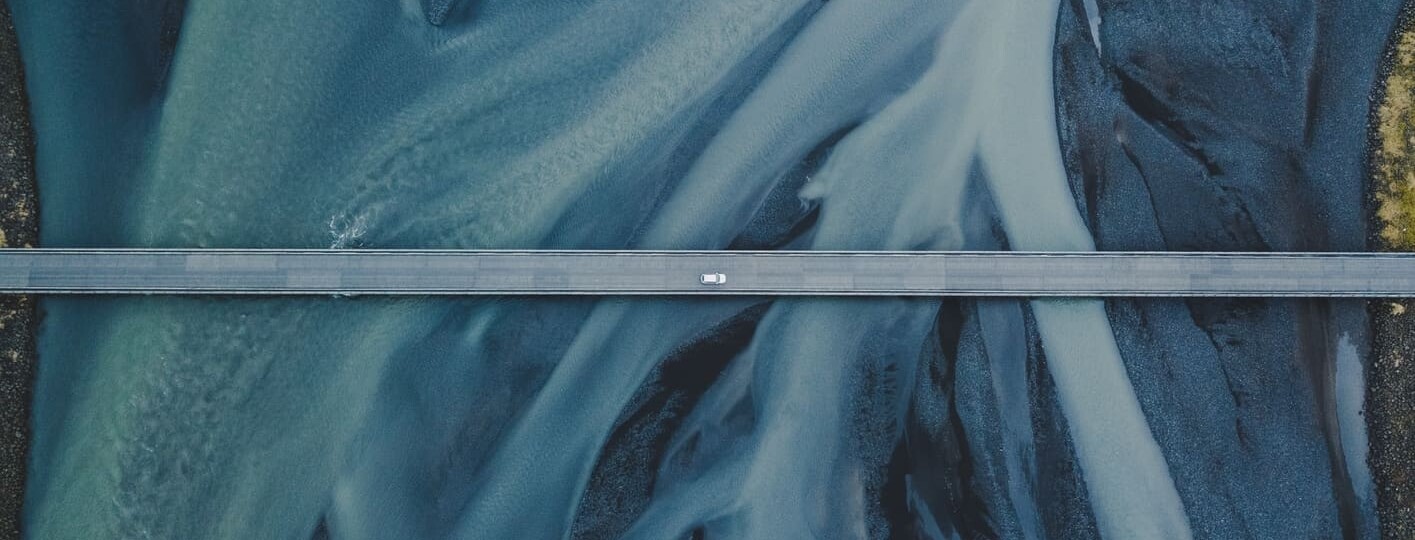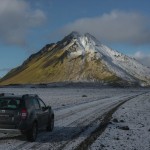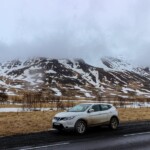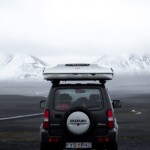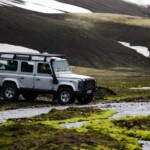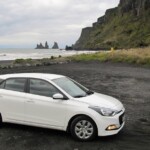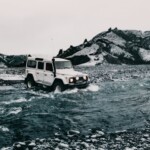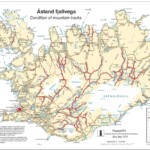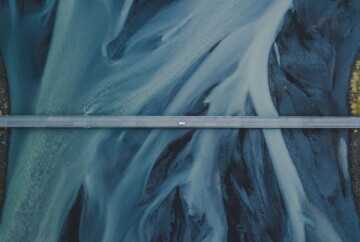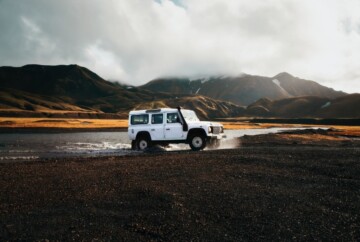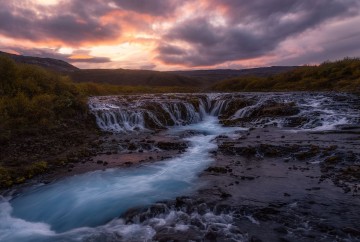Driving in Iceland is not difficult. However, if you’re going to self-drive in Iceland, you need to know the basic rules of the road, as well as what conditions to expect.
While I’ve already written a guide on how to rent a car in Iceland, I thought it’d be a good idea to gather all my tips for driving in Iceland. We’ve learned a lot over the years, thanks to the many trips we have taken to the island, especially during the photo tours in Iceland we do every September.
First, driving in Iceland is safe at any time of the year, provided you respect the basic rules of the road. Even so, in this article, I’ll recommend the type of car you need to drive safely in Iceland, as well as information about road conditions in Iceland, driver’s license requirements, tips for driving in Iceland in winter, and much more.
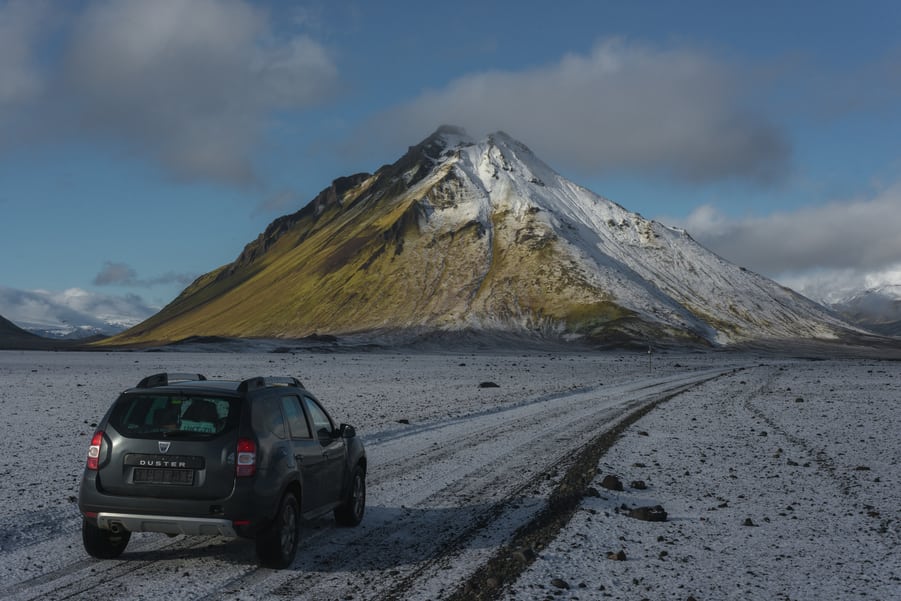
Guide to driving in Iceland
To begin, I want to recommend two invaluable websites and mobile applications that will help you enjoy your road trip through Iceland. The first one is Road.is, the official website for Icelandic roads. On this website, you can see the road conditions in Iceland in real-time. Also, if you’re going to drive a 4×4, you can check if you’ll have to wade through a river when driving on Iceland’s F-roads. You may also download an updated Iceland road map.
The second tool is Vedur.is, which you can use to check the weather before hitting the road every morning. Since the weather in Iceland is very unpredictable, this app is essential.
In this guide to driving in Iceland you will find:
- Basic rules of the road in Iceland
- Types of roads in Iceland
- What kind of car to drive in Iceland
- How to drive in Iceland in winter
- How to drive on Iceland’s F-roads
- Other tips for driving in Iceland
- Iceland road map
Basic driving rules in Iceland
Driving rules vary from country to country, so whenever you plan to travel by car, you should look up the basic rules of the road in that nation. To stay safe and avoid fines, you’ll need to know which side of the road you should drive in Iceland, as well as the speed limits and necessary licenses, among other things. It turns out that being a foreigner doesn’t mean you’re exempt from traffic fines and other driving violations.
To help you safely drive in Iceland, here is a breakdown of the main Icelandic traffic rules.
Iceland driving side
You drive on the right side of the road in Iceland, like in the US, Canada, and most countries in the EU. So, Americans don’t have to worry too much, but the same can’t be said for an Australian or Brit driving in Iceland.
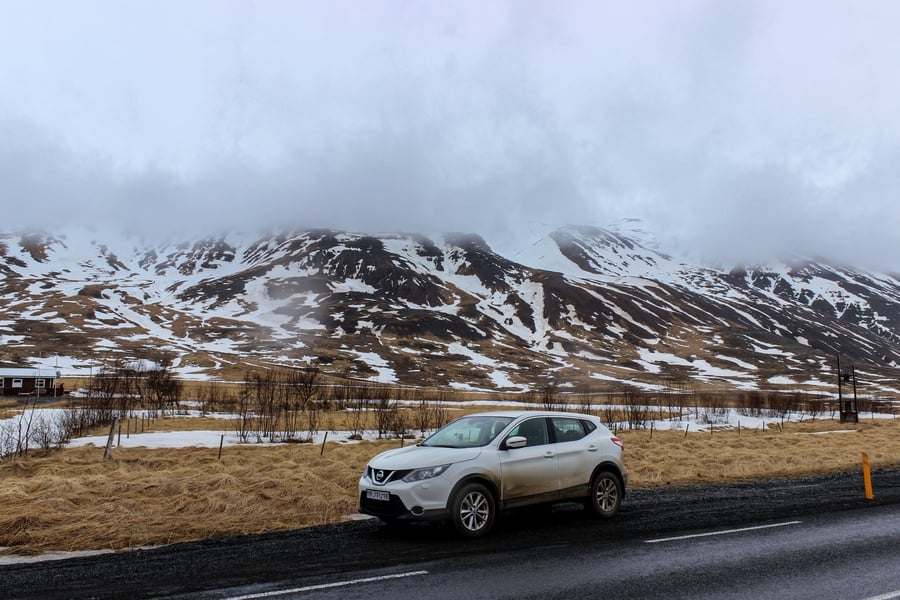
Iceland driving side
However, in some situations, you may have to drive closer to the center of the road. This is mostly likely to happen in the winter when snow has accumulated on the roads. If you find yourself in this situation, the most important thing to remember is to drive slowly and leave room for opposing traffic.
In Iceland, there are still some one-lane roads, bridges, and tunnels that allow two-way traffic. I’ll tell you how to drive safely through them later in this guide.
Driver’s license requirements in Iceland
Most drivers will have no problem driving in Iceland with a U.S. license. The typical Class D license that most U.S. residents have is an acceptable foreign driver’s license in Iceland. The equivalent in Canada is Class G.
Keep in mind that Icelandic car rental companies require the driver to have had held a full driver’s license for at least 12 months.
You can drive in Iceland with an American license in vehicles weighing up to 7,700 lbs. Fortunately, most motorhomes and campervans don’t exceed this weight limit. Cars, SUVs, and Jeeps rarely exceed 4,400 lbs.
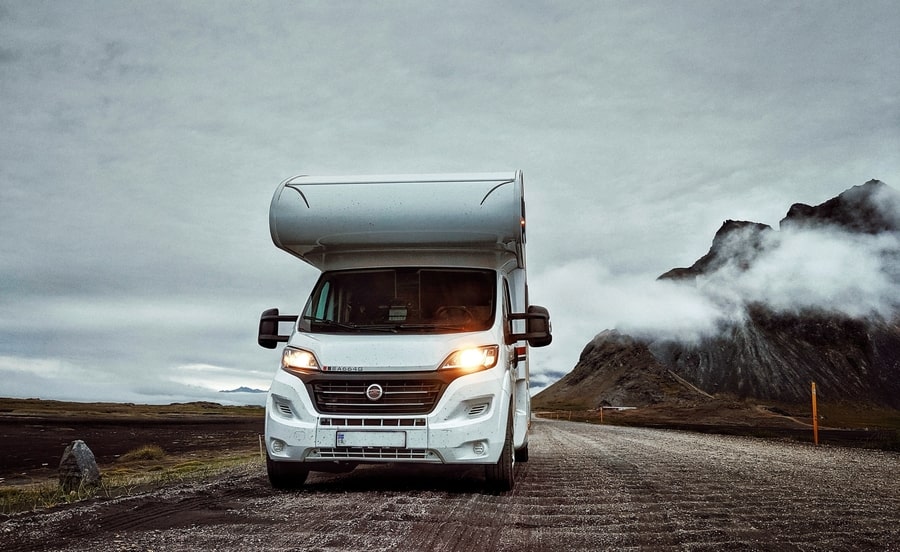
Driver’s license requirements in Iceland
Also, you won’t need any special license or the International Driving Permit (IDP) if your license is issued in English. For driver’s licenses written in a language other than English, you will need an IDP along with your official driver’s license.
Speed limits & speed cameras in Iceland
There is no need for super-fast cars in Iceland because paved roads have a speed limit of 90km/h (55 mph). On unpaved roads, the speed limit is even lower, at 80km/h (50 mph). In urban areas, you can’t go faster than 50km/h (30 mph), and many roads have a speed limit under that.
If the police catch you going faster than the posted speed limit, you can pay the fine immediately at a discounted rate. However, if a fixed speed camera catches you speeding, the Icelandic police will contact your car rental company. If this happens, the business must hand over your personal information to the authorities, and you’ll be charged an extra fine on your rental reservation. Depending on how long it takes to process, you might not receive the fine until after you return the vehicle.
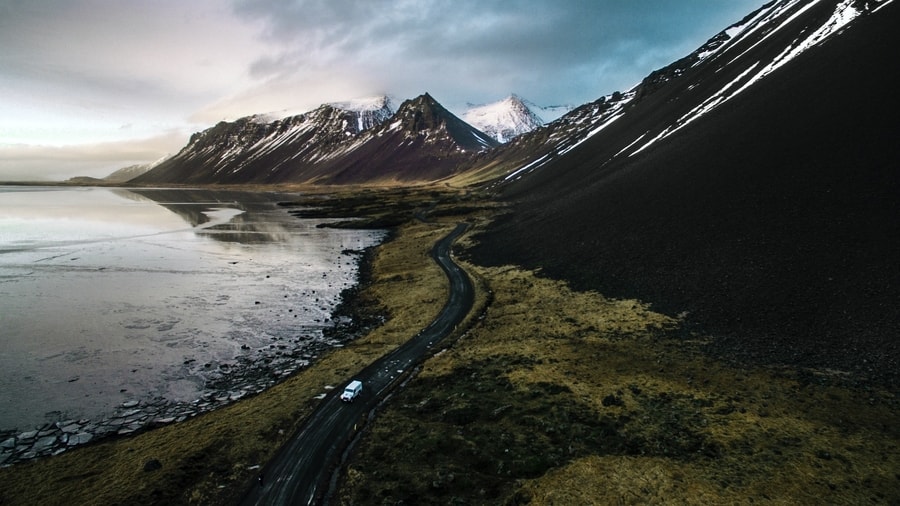
Speed limits & speed cameras in Iceland
There are many speed cameras in Iceland, some fixed and some mobile. You can find them even in the most remote areas. For your safety and to avoid unnecessary fines, I suggest always respecting Iceland’s speed limits. Also, don’t be surprised if the rental company warns you about this before handing over the rental car.
To give you an idea of how much speed tickets in Iceland cost, here’s a typical example. If you drive more than 40 mph on roads limited to 20 mph, the fine will be ISK 90,000 (about $670). If you exceed a speed limit of 55 mph, even slightly, the fine will be ISK 65,000 (about $480). Exceeding 100 mph in Iceland could cost you ISK 240,000 (about $1780).
Keep your headlights on when driving in Iceland
According to the Travel.State.Gov website, it’s mandatory to keep your headlights on during the day in Iceland. The official Road.is website also emphasizes this point in its security section.
Therefore, when driving in Iceland, always remember to keep your lights on, even during the day when there’s lots of light and everything is clear.
This rule applies all year round, even in summer. In fact, driving through Iceland without your headlights on could result in a fine. If you drive during the day without your headlights on, you could be slammed with a fine of ISK 20,000 (about $150).
Iceland’s seatbelt laws
Seatbelts are mandatory in Iceland for both the driver and other passengers. If there are minors in the car, the driver is solely responsible for ensuring that they wear their seatbelts.
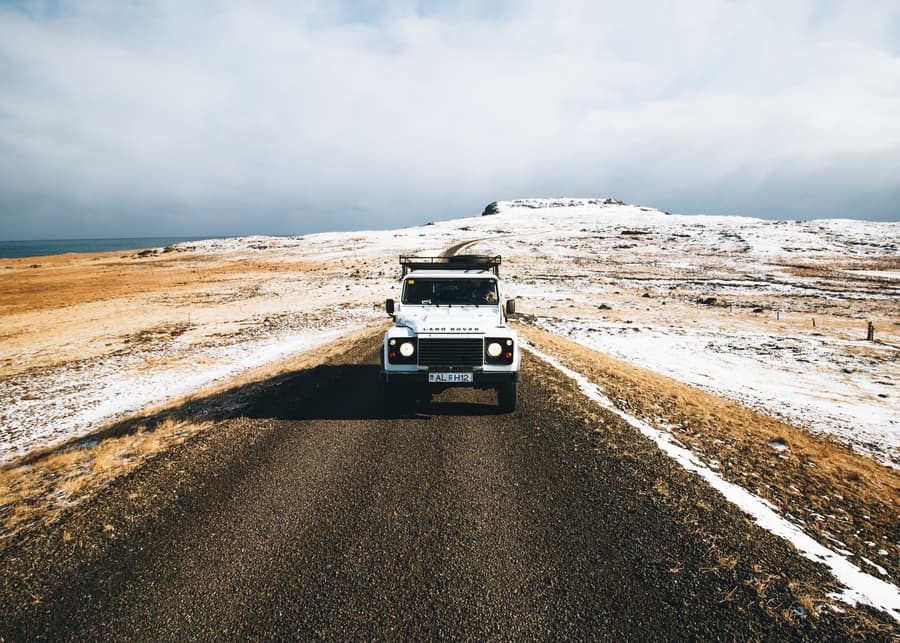
Iceland’s seatbelt laws
If you are traveling with children in Iceland by car, they should be in age-appropriate car seats. Car rental companies can provide car seats, although they come at an extra cost.
Driving in Iceland without a seatbelt, as well as being a passenger without a seatbelt, is subject to a fine, typically ISK 20,000 per passenger (about $150).
Don’t drive off-road in Iceland
Off-road driving in Iceland is strictly prohibited, as is driving on unmarked roads. Not only is this dangerous and potentially damaging to the natural landscape, but it could result in a fine.
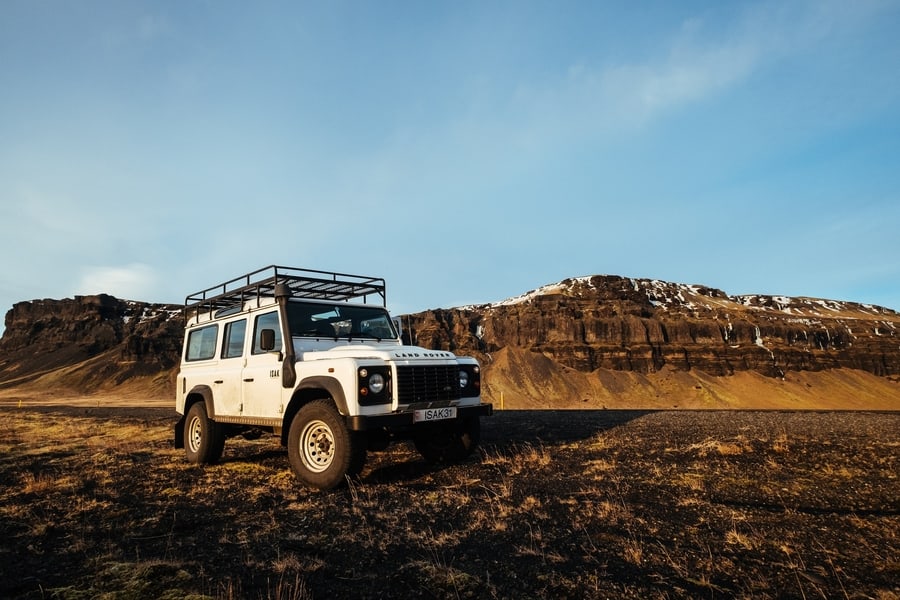
Don’t drive off-road in Iceland
When I mention off-road driving, I’m not talking about driving on Iceland’s F-roads, which are unpaved but signposted mountain roads. You can find these roads in the Highlands of Iceland, and you’ll need a 4×4 to drive them.
If you’re not sure which roads and paths you can drive, I suggest downloading our road map of Iceland. Also, remember that Road.is is the best platform to check on the state of Iceland’s roads.
Don’t use your cell phone when driving in Iceland
Just like in most countries, driving in Iceland while using a cell phone is outlawed.
We use a magnetic phone mount that takes up very little space and lets us access our phone’s GPS. If you also want to use your cell phone but don’t have a mount like ours, it’s best to have one of your passengers or friends help you out. A mobile GPS unit is a huge help, but you shouldn’t hold it while driving. Instead, put it down someplace stable so you can hear the directions without having to look down at it.
If you need to make a call or use your cell phone for something, you will have to park the vehicle so you can use it safely.
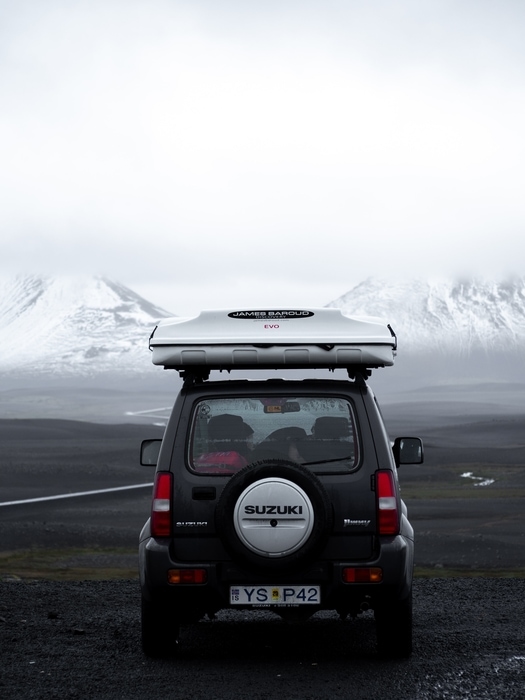
Don’t use your cell phone when driving in Iceland
Driving in Iceland while looking at a cell phone can be very dangerous, as it takes your eyes off the road. It is also another reason for the Icelandic police to fine you. In this case, the penalty is ISK 40,000, which is about $295.
Drunk driving laws in Iceland
Icelandic legislation prohibits driving under the influence of alcohol or any type of drug.
Icelandic laws are some of the strictest in the world in this regard. The current legal blood alcohol limit is 0.05%, although some are trying to lower it to 0.02%. Exceeding this limit will result in a hefty fine, about ISK 60,000, which is approximately $470.
Keep in mind that, depending on your weight, one beer or glass of wine could send you over the legal blood alcohol limit. Driving under the influence of alcohol is the second leading cause of accidents in Iceland, behind speeding. Don’t risk it! Besides, you’ll need all your focus to maneuver the challenging roads of Iceland.
VIOLATIONS | COST OF FINE |
|---|---|
Drive more than 40 mph with a limit of 30 mph | ISK 90,000 (approx. $660) |
Drive more than 55 mph with a limit of 55 mph | ISK 90,000 (approx. $660) |
Drive more than 100 mph with a limit of 55 mph | ISK 150,000 (approx. $1,110) |
Using a cell phone while driving | ISK 5,000 (approx. $35) |
Running a red light | ISK 15,000 (approx. $105) |
Not wearing a seatbelt | ISK 10,000 (approx. $70) |
Not having headlights on during the day | ISK 5,000 (approx. $35) |
Failing to respect a "Yield" sign | ISK 15,000 (approx. $105) |
Driving under the influence of alcohol | ISK 20,000 (approx. $140) |
Exceeding speed limits under the influence of alcohol | ISK 320,000 (approx. $2,350) |
TRAFFIC FINES IN ICELAND |
|
What kinds of roads are there in Iceland?
There are three types of roads in Iceland, and as a tourist driving in Iceland, it’s a good idea to know the type of car each road requires. You should also get familiar with the speed limits of each type of road, as well as any considerations you should take before driving.
The Ring Road and other paved roads in Iceland
Iceland has a good paved road system. These roads connect most of the urban areas on the island, making it easier to reach the main tourist attractions of Iceland.
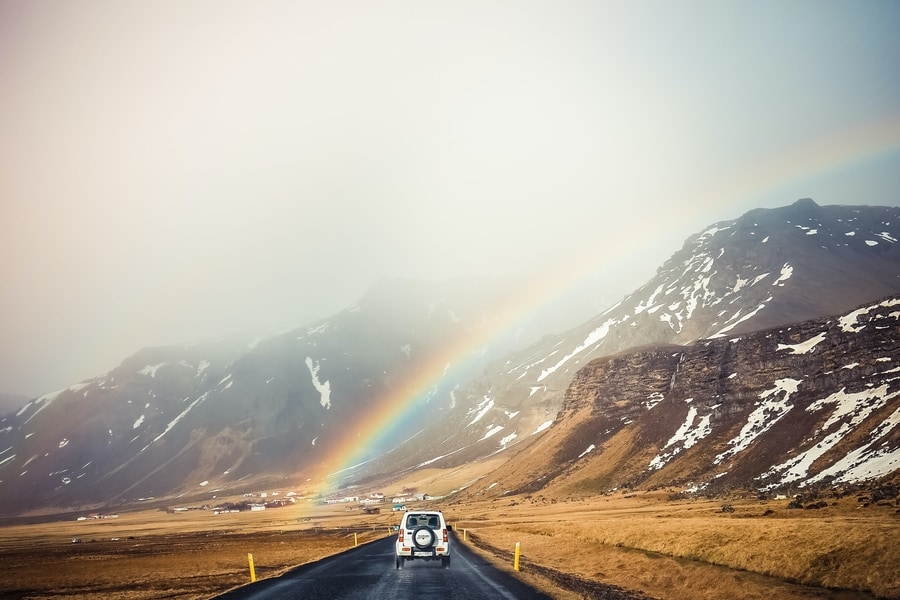
The Ring Road and other paved roads in Iceland
The Ring Road, which borders the island, is almost 840 miles long. It’s also the main connector of Iceland’s roads. In some areas of Iceland, the Ring Road is only a narrow, paved road, while in places near Reykjavík, it resembles a highway.
Also known as Route 1, driving along the Ring Road isn’t too difficult. That said, we’ve written a specific article about planning an Iceland Ring Road trip.
Gravel roads in Iceland
To get to the far corners of the country, you’ll need to drive on some of the gravel roads in Iceland. But don’t worry, many of these roads are suitable for all kinds of vehicles, including 2WD cars.
These gravel roads are typically classified the same as asphalt roads and they’re marked on the road maps with a number. To check if your itinerary goes through a gravel road, I recommend checking this map.
In any case, don’t worry about needing a special vehicle to traverse these roads. If you do want to take extra precautions, I suggest purchasing gravel protection insurance. You can read more about that in our guide to renting a car in Iceland. Regardless of whether you get extra coverage, always drive carefully and slowly on these roads.
F-road roads in Iceland
Iceland’s F-roads are mountain roads that you can find in the Highlands. These paths are not maintained during winter, so they are usually closed for much of the year.
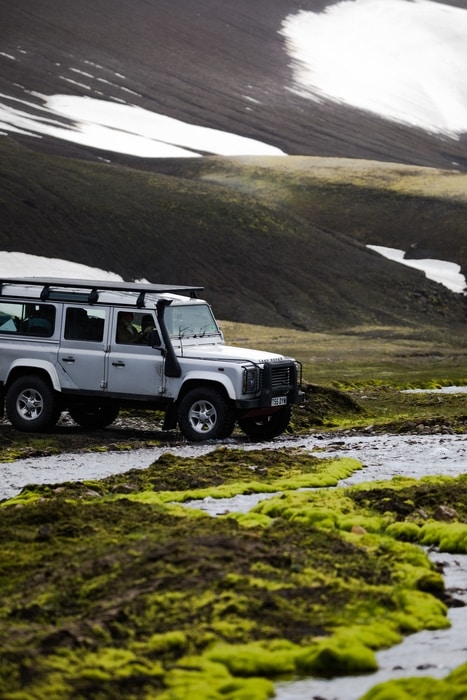
F-road roads in Iceland
To drive on these F-roads, you must have a 4×4 vehicle, although not all 4×4 cars are suitable for this job.
You must be extra careful since a normal gravel road can quickly become an F-road. Fortunately, there are road signs that will let you know ahead of time. Pay attention and you won’t be caught on an F-road with an inadequate vehicle.
In general, F-roads are marked with an F in front of the number. They’re usually narrow and unpaved, with a speed limit of 30 mph. Some of these roads are crossed by rivers, which you can wade through if you have the right vehicle. Later, I’ll share some tips for crossing rivers in Iceland. However, I’m not aware of any car insurance policies that cover damages or issues that result from wading through rivers. So, do this at your own risk.
Which type of car is best to drive around Iceland?
Although we’ve covered this in more detail in our guide to renting a car in Iceland, I’d like to give you some quick tips to help you decide what type of car to drive in Iceland.
Once you’ve chosen a route and you know the type of roads you will be driving on, as well as when you’ll travel, you can select an appropriate vehicle for your Iceland road trip.
A standard rental car is ideal if you’re driving on paved roads and you want to enjoy the main attractions along the Ring Road. Even if you occasionally must veer off a gravel road, you won’t have a problem. Of course, it is not the type of vehicle I would suggest if you’re going to drive through Iceland in winter since it is easy to find ice on the roads during this season. In that case, a 4×4 will be much safer than a front-wheel drive car.
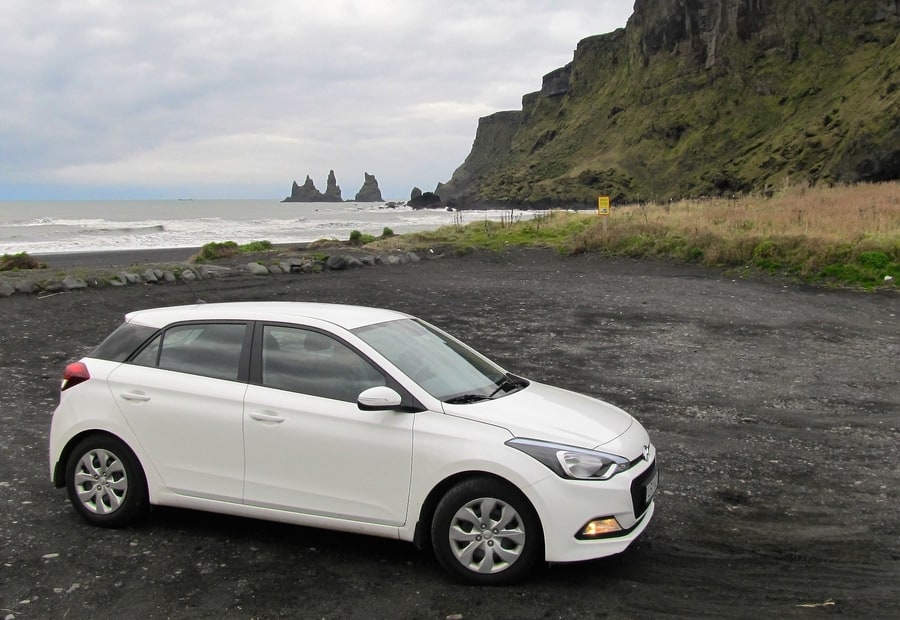
Which type of car is best to drive around Iceland?
A 4×4 vehicle is perfect if you’re driving on all types of roads, including F-roads. It’s not only the safest option, but the most comfortable too. If you’re going to travel around the Highlands or drive around Iceland in winter, I definitely recommend a 4×4 car. It’s more expensive, but it’s also much safer.
You could also rent a motorhome or a campervan to explore Iceland at your own pace without worrying about accommodations. Besides, RVs are perfect for the summer months. We’ve only driven a motorhome in Iceland once, and we got our rental from Motorhome Republic.
How to drive in Iceland in winter
Many travelers wonder if driving in Iceland in winter is dangerous. Speaking from experience, I can tell you that it’s not, as long as you have the right vehicle, drive at a reasonable speed, always keep your headlights on, and follow Icelandic traffic regulations. However, there are a few precautions I recommend if you’re going to drive in Iceland in winter.
Although you should do this any time of the year, in winter it’s essential that you check the Road.is website to see the road conditions in Iceland. There, you can see if any roads are closed. While F-roads are most likely to be cut off after major snowstorms, other paved roads may also shut down.
You should also check Vedur.is to see the weather forecast. You should always anticipate harsh weather conditions during the winter. Preparation is your number-one defense when dealing with Iceland’s unpredictable forecasts.
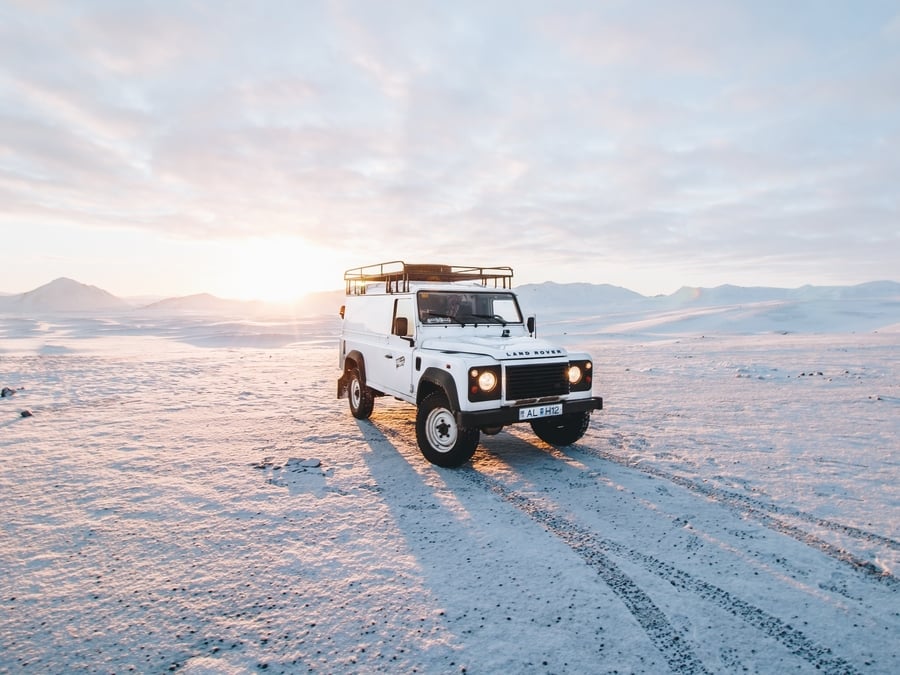
How to drive in Iceland in winter
To drive around Iceland in winter, I suggest renting a 4×4 even if you are only going to travel on paved roads. In winter, it’s very common to find ice and snow on the roads, and a 4×4 vehicle will give you more security and traction.
It is very important that you feel comfortable on the road, so if you think there’s too much snow or it feels unsafe, look for alternative routes.
Moreover, you should always have sunglasses in your glove compartment. This may seem strange, but the sun’s reflection off the snow could damage your eyes. In Iceland, the sun is constantly on the horizon during the winter, so you don’t want to forget your shades.
Other must-haves on the road include plenty of water, snacks, and a full tank of gas. While it’s unlikely, there is always the chance of breaking down in the middle of nowhere in below-freezing temperatures and several feet of snow.
How to drive on Iceland’s F-Roads
To drive on the F-roads in Iceland, you will need a 4×4 and patience. Although the speed limit on these roads is 30 mph, you’ll probably need more time to reach your destination than what your GPS thinks, so plan accordingly.
Before driving through Iceland’s Highlands, make sure you have a full gas tank and enough food and water. There aren’t any service areas, supermarkets, or restaurants along Iceland’s mountain roads, so it is important to be prepared.
Also, check the weather forecast on Vedur.is, and look on Road.is for information related to road closures. Iceland’s F-roads remain closed in winter, but you can check the opening dates here. Moreover, this map will show you the current state of Iceland’s roads.
To find out if your planned route involves fording rivers, use this specific map and look for a (V) sign on the mountain roads. Please remember that not all 4×4 cars are capable of crossing Iceland’s rivers, which can be quite strong. It’s best to first call +354-522-1100 for information about any rivers that pass through your itinerary route.

How to drive on Iceland’s F-Roads
I also highly recommend requesting trip monitoring on safetravel.is. On this website, you can share your travel updates, such as when you enter the Highlands, which roads you’re going to take, and where you’re spending the night. Most importantly, you can record the exact time you expect to finish your adventure through the F-roads. This way, if you haven’t posted any updates two hours after your end time, a rescue service will dispatch and look for you.
There is no cell coverage in the Highlands, so you won’t be able to use a conventional GPS. I suggest downloading the Maps.me app and our Iceland road map. Also, if you don’t have a satellite communicator, I highly recommend renting a personal location beacon (PLB). It costs about $10 and can literally save your life if you need to be rescued. We personally use the Garmin inReach.
Finally, always drive at a reasonable speed, keep your headlights on, and pay close attention to the terrain. Even if you go much slower than on a paved road, it’s easier to lose traction and control of the vehicle on an F-road.
Crossing rivers in Iceland
Before telling you how to cross Iceland’s rivers with an 4×4, you should know that no rental car insurance covers the damage caused by trying to wade through a river. Any time you cross a river, you’re doing it at your own risk, so keep in mind that the cost of repairing a water-damaged engine or transmission can exceed $25,000.
Our advice is, if possible, to wear waders that allow you to cross the river on foot. This will allow you to check the depth of the river before driving through. While you’re at it, check to be sure there aren’t any hidden underwater obstacles.
Crossing a river for the first time can be nerve-wracking, so try to stay calm. Look for the shallowest section, which is usually where the river widens. If you see an area with calm water, it’s most likely the deepest spot. If you have any doubts, wait for another car to pass to see how deep the river is. Another trick is to look on the other side of the river to see if other vehicles left tracks along the bank.
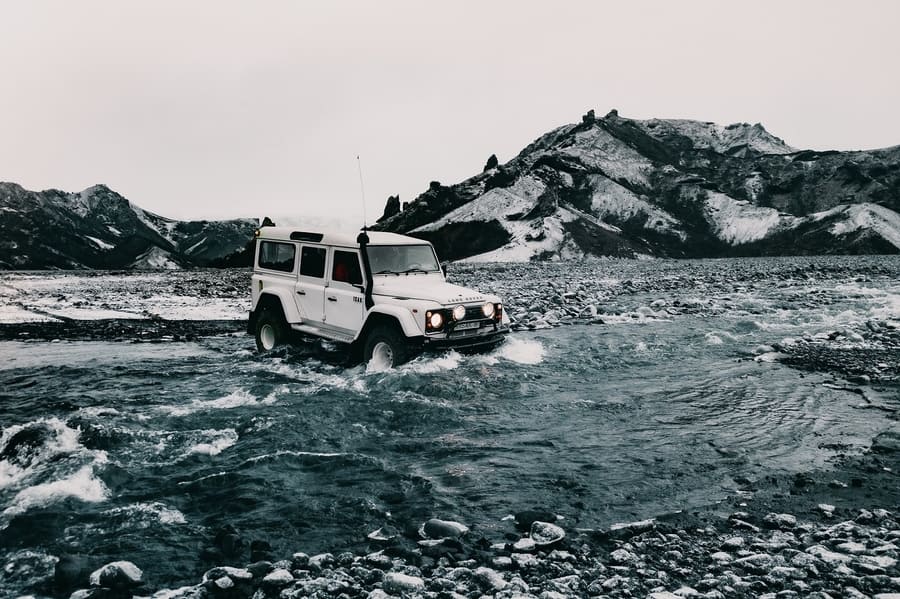
Crossing rivers in Iceland
You must cross the river with the vehicle in first gear. Also, make sure you put the car in four-wheel drive mode. Keep a constant speed and don’t accelerate or brake while fording the river.
If you can’t find a clear path, turn around and look for alternative routes. In the Highlands, you won’t have phone coverage, so it can be hours until someone passes by and helps you. This is why it’s always safer if you cross the river with another car.
If you have no experience driving on these types of roads and you feel scared or insecure, don’t push yourself. Luckily, there are excursions from Reykjavik to visit the Highlands, so you don’t have to go on your own. My favorites are this tour to visit Landmannalaugar and this hiking tour through Thorsmork.
While this area of the island fascinates me, I assure you that there are many things to do in Iceland, so you can still have an authentic experience without visiting the Highlands.
Things you need to know for a self-drive Iceland trip
Before you embark on a road trip through Iceland, there are a few important things that you must know, such as where to find gas stations or parking spots.
Of course, when planning their trip, many people are more concerned with finding a cheap rental car or good places to stay in Iceland rather than those little details that could complicate things. So, if you’re going to drive through Iceland on your own, I suggest taking note of everything in this guide to enjoy your trip to the fullest and avoid unnecessary worry.
Gas stations in Iceland
As long as you drive on paved roads, you won’t have any problems finding gas stations in Iceland. These are usually very well-located, so you’ll find them in any popular attraction or common road you’ll pass through.
However, finding a gas station becomes a problem when you’re traveling inland, in remote places far from towns and cities, or along F-roads. If this is the case, I recommend locating gas stations along your route ahead of time. Also, fill up your gas tank before going into these kinds of places so you’ll reach the next station without any problems.
I suggest you avoid straying too far from your route without checking the amount of gasoline you have left in the tank or how close you are to the nearest gas station. Also, avoid speeding or hurrying along, as you could end up missing a turn and deviating from the planned path. If you’re left stranded, it may be hours before someone can help you.
To help you plan, here is a map of all the gas stations in Iceland.
Parking in Iceland
You will find free parking in Iceland almost everywhere, except in some parts of Reykjavik, and in some of the most important attractions in the country such as at the Seljalandsfoss waterfall, Thingvellir National Park, Kerid crater, and Stokksnes beach.
Make sure you only park in designated areas. If you feel the need to park on the road, stay off the main roads and make sure your vehicle is visible to avoid accidents. Although Iceland has fascinating landscapes, parking in the middle of the road to take a photo is very dangerous, and you can be fined for it.
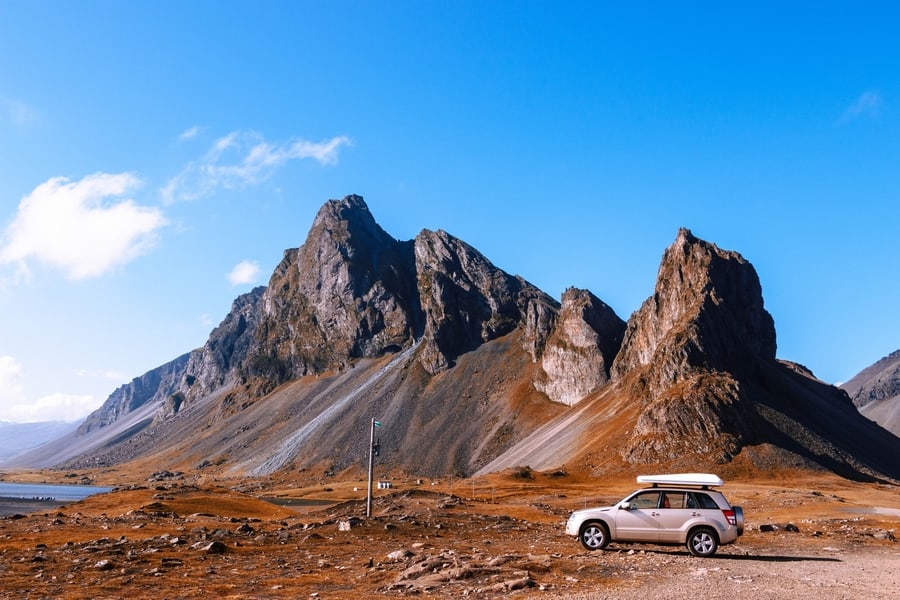
Parking in Iceland
Reykjavik is divided into four parking areas. The closer you are to Laugavegur, the main street of Reykjavík, the higher the cost of parking. The price ranges between ISK 90 and 250 per hour (about 60¢ to $2.35). However, on Sundays you can park for free in all areas in Reykjavik. The orange areas are also free on Saturdays.
At the Seljalandsfoss waterfall, the cost of parking depends on the type of vehicle. The price is usually around ISK 700 per day (about $6). Thingvellir recently enabled paid parking areas, which cost ISK 750 each ($5.50), and the Kerid crater has also started charging ISK 400 a day (about $3). Stokknes Beach was one of the first places to enact paid parking, and today the price is ISK 900 per person (about $7).
Generally speaking, you won’t have any problems finding parking in Iceland. However, I still recommend checking the parking rates and time limits in the cities, especially if you’re going to explore the best things to do in Reykjavik for a couple of days.
One-lane bridges in Iceland
There are still several single-lane bridges in Iceland, although the number decreases each year. When crossing these, you must be very careful not to run into another vehicle. Drive slowly and cautiously each time you reach a bridge, and yield if another vehicle is crossing or has reached the other end of the bridge earlier.
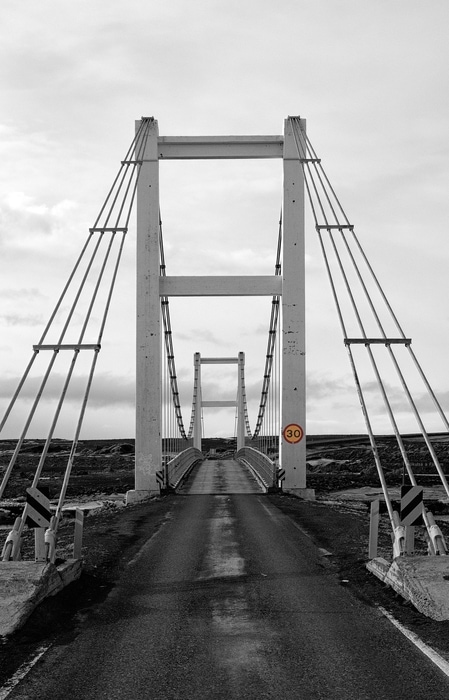
One-lane bridges in Iceland
In this particular scenario, keep your car close to the right-hand side so you don’t stop the flow of traffic. If you’re not sure who should cross the bridge first, simply yield to the other driver.
Tolls in Iceland
If you are going to drive in Iceland, you’ll be happy to learn that you don’t have to worry about tolls. There are no tolls in Iceland except for one in the Vaðlaheiðagöng tunnel, which goes from Mývatn to Akureyri and cuts your route by 10 miles and 15 minutes.
If you want to cross the Vaðlaheiðagöng tunnel, you’ll have to pay ISK 1500 (about $12). You have to pay it in advance online by registering on the official page. You won’t be charged if you end up not going through the tunnel, and the payment won’t be processed until three hours after you go through. If, after three hours, you haven’t paid the fee, your car rental company will deduct the payment from your deposit. They’ll also charge you a higher rate, ISK 2,500 (about $18).
Other tips for driving in Iceland
To make driving through Iceland safe and easy, I’ve complied my top tips to take into account.
1. Check the weather forecast before driving anywhere
Always, before and during the road trip, check the weather forecast, as it can change at a moment’s notice. It is not unusual that, after a sunny morning, you’re faced with a snowstorm while behind the wheel. So, it is always good to be prepared.
Also, always wear warm and waterproof clothing, just in case.
We use the Vedur.is website and app to stay up to date on Icelandic weather conditions. It’s also one of the best tools for finding the best places to see the northern lights in Iceland, based on cloud conditions. If you are going to drive in Iceland, I recommend downloading the app to your phone.
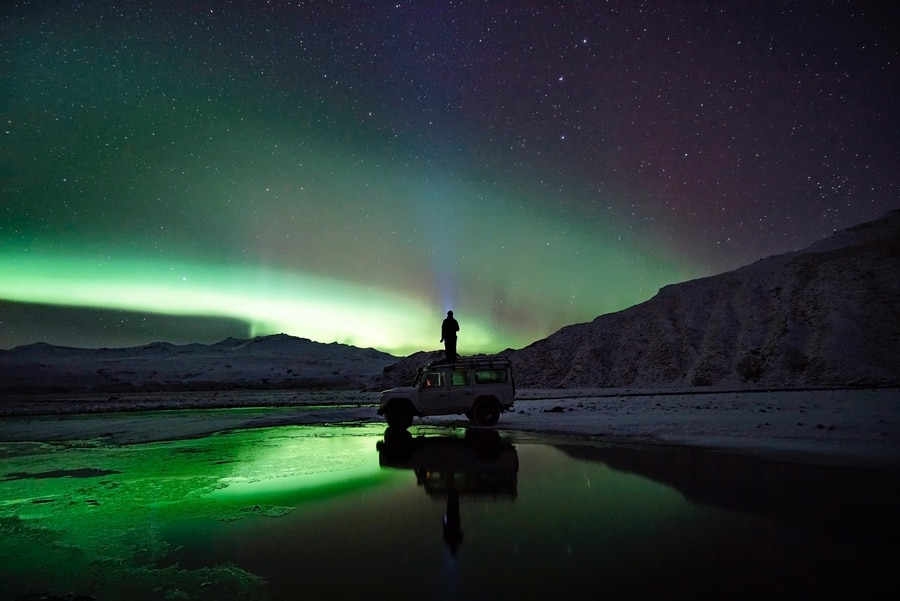
1. Check the weather forecast before driving anywhere
2. Check the road conditions in Iceland on Road.is
Always check the state of Iceland’s roads through the Road.is website before setting out on the road. This way, you will know if any roads are closed, as well as if there is snow accumulation, road work, or any traffic accidents that would force you to take an alternative route.
If you have any questions, you can also call +354-522-1100 during regular office hours.
3. Plan your itinerary using an Iceland road map
Always use a road map of Iceland to plan your trip. This way, you’ll have a better idea of the types of roads you’ll go through, any nearby towns or cities, as well as if you’ll need to cross rivers. This is the best way to figure out the type of car you’ll need. It will also make it easier to calculate driving times in Iceland and design your itinerary and route, taking into account gas stations, restaurants, and accommodations.
I suggest taking a look at our road map of Iceland.
4. Avoid driving at night in Iceland when possible
I recommend you avoid driving at night in Iceland as much as possible. Of course, there are some months when the daylight hours are reduced, so sometimes nighttime driving can’t be avoided.
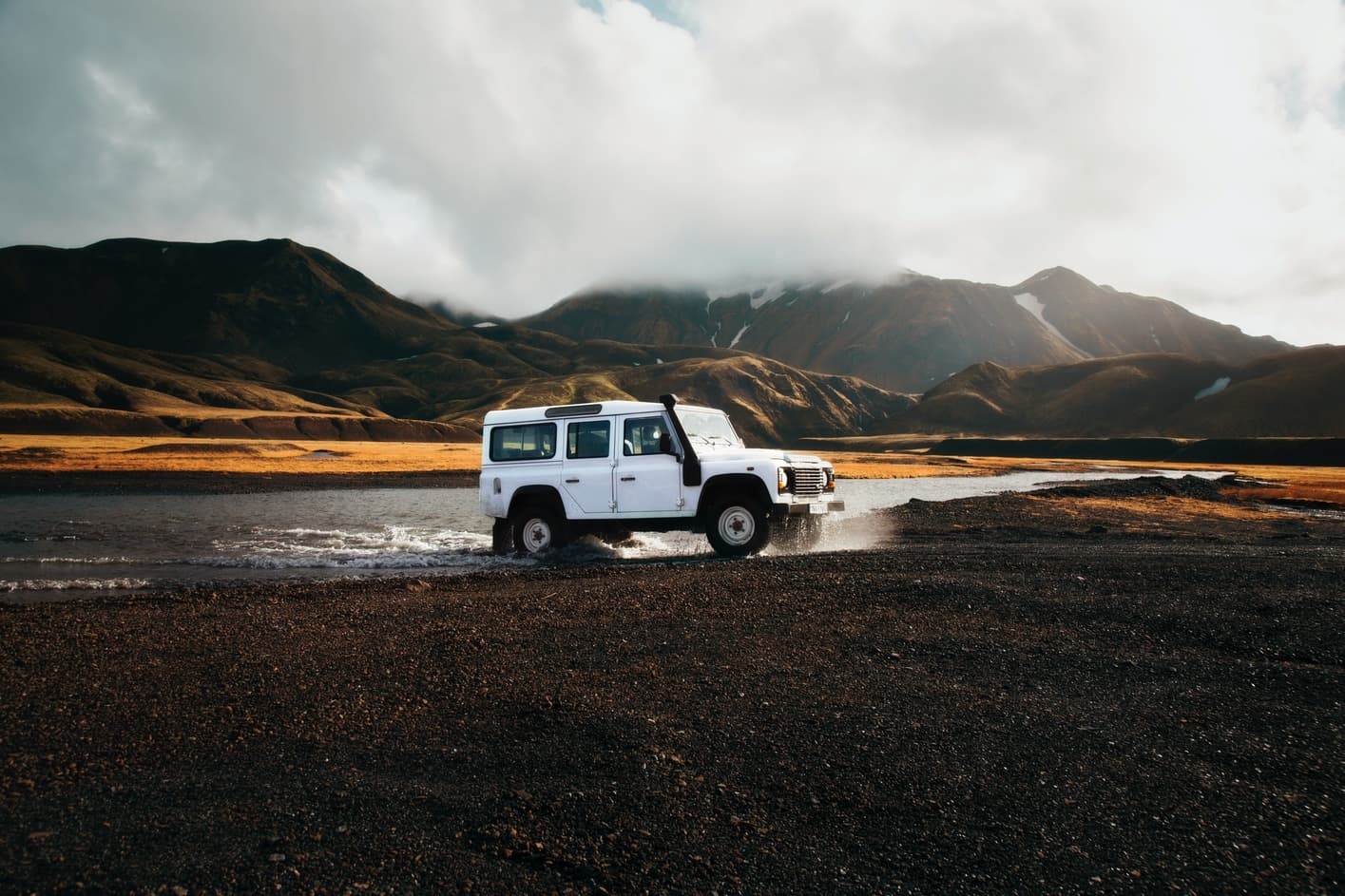
4. Avoid driving at night in Iceland when possible
Generally speaking, driving at night on a paved road shouldn’t be a problem, especially if you respect the speed limit. However, you should avoid unpaved roads at night, especially F-roads.
5. Watch out for animals crossing the road
It is very common to see animals crossing the roads in Iceland. Don’t be surprised if you spot some stray creatures while you’re driving around the island. Yet, most insurance policies don’t cover damage caused by a collision with an animal, so be extremely careful.
In Iceland, there are sheep everywhere, and they graze freely without any fencing. Similarly, Icelandic horses can cross the roads when you least expect it. While they’re a beautiful sight to see, you couldn’t harm these creatures and destroy your vehicle if you aren’t careful.
I suggest always keeping a reasonable speed in areas where animals can cross. This will give you time to react if they do cross the road. If you’re driving at night in Iceland and there isn’t any oncoming traffic, keep your high beams on for better visibility.
6. Fill up on gas early and often
While you won’t have problems finding gas stations along Iceland’s paved roads, it’s a different story on the F-roads and secondary paths. Make sure you have a full tank of gas when you go through areas where you won’t be able to refuel, and always consider the distances between gas stations when planning your route.

6. Fill up on gas early and often
7. Don’t stop in the middle of the road
Never stop your car in the middle of the road in Iceland. If you need to stop, do so only in designated areas. If it’s urgent, be sure to exit the main road and park someplace where your vehicle will be seen by other drivers.
Yes, the landscapes of Iceland are amazing, but it’s not worth risking your safety just to get a photo for social media.
8. If you think it’s unsafe, turn around & go back
If you’re on an F-road (or any other road) and you feel unsure about the conditions, turn around and find an alternative path. It’s not uncommon to find yourself in this situation while driving on Iceland’s mountain roads. In the Highlands, you may come across a river or other obstacle that might make you feel uncomfortable.
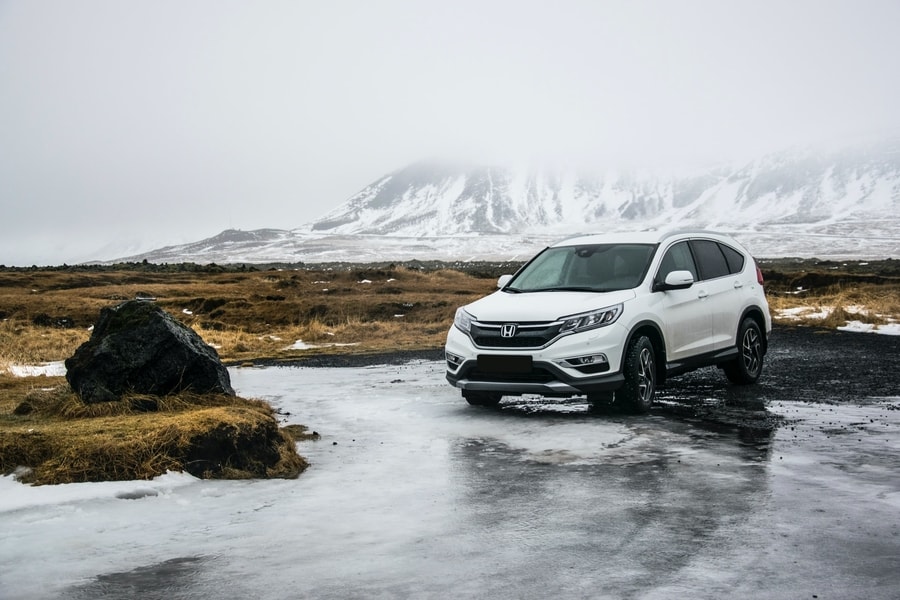
8. If you think it’s unsafe, turn around & go back
In these scenarios, trust your intuition. If you have a gut feeling that it’s dangerous, you’re probably right.
9. Wind can be dangerous in Iceland
Take extra considerations of the wind when driving through Iceland, especially when opening the car doors. From my experience, it’s best if the driver gets out first and holds the door open for the rest of the group. It may seem like an exaggeration, but the winds in Iceland can blow the doors open, and I’ve actually seen this myself.
The wind isn’t only dangerous to vehicles, but also to people. During strong windstorms, look for an alternative plan that doesn’t involve driving, if you can. A strong gust of wind could even veer your car off the road.
10. Call 112 if you get involved in a car accident in Iceland
If you have any problems on the road in Iceland, call 112. This is the Icelandic helpline for drivers who have any issues, such as getting trapped in snow, running out of gas, or getting involved in an accident.
Iceland Road Map
While we have already compiled all the maps of Iceland, we want to mention them here. They’re a must-have for anyone who wants to drive around Iceland.
If you click on the image, you can get a closer look at Iceland’s F-roads on the map.
Are there other transportation options besides driving in Iceland?
Keep in mind that you can travel around Iceland without driving. So, if after reading this article, you decide that you don’t want to worry about traversing the rugged Icelandic roads, here are some of the best Iceland vacation packages.
Driving in Iceland FAQ
If you still have questions about driving in Iceland, check out the answers to these FAQs.
And that’s everything! I hope that now you feel much more prepared to drive through Iceland. If you’re careful and pay attention, driving in this country doesn’t have to be dangerous. If you have any questions, feel free to leave me a comment. The roads of Iceland are waiting for you!
